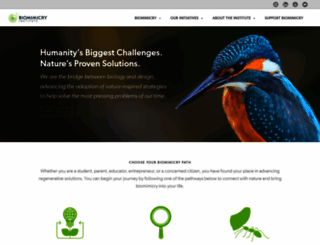The Biomimicry Institute — Nature-Inspired Innovation
Page Load Speed
11.4 sec in total
First Response
3.2 sec
Resources Loaded
7.9 sec
Page Rendered
279 ms

About Website
Welcome to biomimicryinstitute.org homepage info - get ready to check Biomimicry Institute best content right away, or after learning these important things about biomimicryinstitute.org
The Biomimicry Institute is on a mission to help solve humanity’s biggest challenges through the adoption of biomimicry (nature-inspired innovation) in education, culture, and industry.
Visit biomimicryinstitute.orgKey Findings
We analyzed Biomimicryinstitute.org page load time and found that the first response time was 3.2 sec and then it took 8.2 sec to load all DOM resources and completely render a web page. This is a poor result, as 85% of websites can load faster.